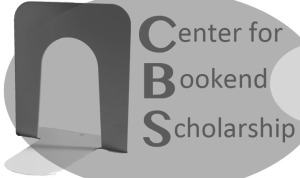 The Center for the History of Medicine and Public Health is excited to announce the founding of its newest program, the Center for Bookend Scholarship. Through the Center for Bookend Scholarship, we aim to foster knowledge and appreciation of the most underappreciated object in the history of the book. We will encourage scholarly and public interest in the bookend through exhibitions, public programs, and research opportunities.
The Center for the History of Medicine and Public Health is excited to announce the founding of its newest program, the Center for Bookend Scholarship. Through the Center for Bookend Scholarship, we aim to foster knowledge and appreciation of the most underappreciated object in the history of the book. We will encourage scholarly and public interest in the bookend through exhibitions, public programs, and research opportunities.

Book storage methods as shown in our 1509 edition of Fasciculus Medicinae. Click to enlarge.
Early libraries did not need bookends. People arranged books horizontally into the 16th century (and perhaps longer). Only once enough books existed to fill up a bookshelf—which only started to resemble the furniture of today in the 16th century—without falling over did libraries begin to store books vertically.1
It took even longer for people to shelve books spine-out. Many Medieval and Renaissance libraries chained books to lecterns and shelves; in order to attach the chain without causing damage, these libraries stored books fore-edge out. In the 16th century, books began to include authors and titles on their spines, though not universally, a sign that shelving practices included spine-out configurations. By the next century, nearly all books had bibliographic information on their spines.1
Bookends are a relatively new technology. The familiar L-shaped metal kind were first patented in the 1870s.1 It took some decades before the term became common parlance: the Oxford English Dictionary records 1907 as the first year the term “book end” appeared in print.2
The New York Academy of Medicine Library has long held an interest in the bookend. Since our founding in 1847, we have intentionally amassed thousands of bookends. Strengths of the collection include American and functional bookends, but we are beginning to add to our European and decorative holdings. Through the Center for Bookend Scholarship, we will now dedicate more time and attention to these objects as we move forward in building the world’s preeminent collection.
Below is a selection of bookends from our collection.
References
1. Petroski, H. (2000). The book on the bookshelf. New York: Vintage Books.
2. book, n. (2014). OED Online. Oxford University Press. Retrieved from http://www.oed.com/view/Entry/21412

Genius!! Thanks.
Finally, the support I need to finish my magnum opus: Die rechtschaffen Bibliotek:
Geisteswissenschaften der Büchenunterstützunggerät. NYAM’s collection of mid-century supports, especially your shelf-latching models in utilitarian chromatics, is supposed to be incomparable, and are sure to be a key addition to volume 7.
A fascinating read!
Pingback: MedHum Mondays: NYAM on Public Outreach | Fiction Reboot | Daily Dose